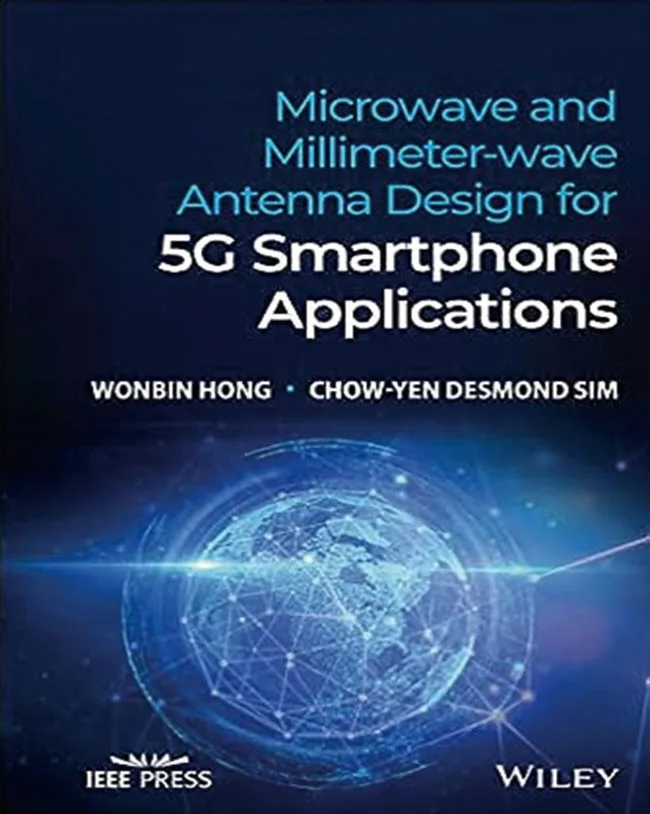- 定價217.00元
-
8
折優惠:HK$173.6

|
|
|
|
MICROWAVE AND MILLIMETER-WAVE ANTENNA DESIGN FOR 5G SMARTPHONE APPLICATIONS?
|

|

沒有庫存
訂購需時10-14天
|
|
|
|

|
|
9781394182428 | |
|

|
|
HONG,SIM (沈昭元) | |
|

|
|
全華圖書 | |
|

|
|
2023年9月06日
| |
|

|
|
1283.00 元
| |
|

|
|
HK$ 1218.85
|
|
|
|
|

| |
|
|
|
|
| |
|
|
詳
細
資
料
|
ISBN:9781394182428叢書系列:實用電子規格:精裝 / 368頁 / 16 x 23 x 5.15 cm / 普通級 / 單色印刷 / 初版出版地:台灣
實用電子
|
|
分
類
|
專業/教科書/政府出版品 > 電機資訊類 > 電信/通訊 |
同
類
書
推
薦
|
|
|
內
容
簡
介
|
Microwave and Millimeter-wave Antenna Design for 5G Smartphone Applications
In-depth and practical coverage of design considerations for 5G antennas
In Microwave and Millimeter-wave Antenna Design for 5G Smartphone Applications, two distinguished researchers deliver a holistic, multidisciplinary approach to antenna design methodologies. The book covers approaches ranging from sub-6GHz microwave to the millimeter-wave spectrum, explaining how microwave and millimeter-wave 5G antennas coexist and function, both independently and collaboratively.
Perfect for antenna, microwave, communications, and radio-frequency engineers, Microwave and Millimeter-wave Antenna Design for 5G Smartphone Applications will also benefit graduate students, policymakers, regulators, and researchers with an interest in communications and antennas.
本書特色
The book offers coverage of key considerations for designing millimeter-wave 5G antennas within space-constrained mobile devices, as well as practical concerns, like cost, fabrication yield, and heat dissipation. Readers will also find explorations of the likely future directions of 5G antenna evolution, as well as:
- A thorough introduction to basic concepts in 5G FR1 Band mobile antenna design, including discussions of antenna placement, element design, and topologies
- Comprehensive explorations of antenna feeding mechanisms and impedance matching, including chassis considerations and effects
- Practical discussions of frequency tunable millimeter-wave 5G antenna-in-package
- Fulsome treatments of compact millimeter-wave 5G antenna solutions and millimeter-wave antenna-on-display technologies for 5G mobile devices
|
|
目
錄
|
About the Authors ix
Preface xi
Acknowledgments xiii
1 Introduction 1
References 4
2 Considerations for Microwave and Millimeter-Wave 5G Mobile Antenna Design 5
2.1 Frequency Characteristics and Channel Models 6
2.2 5G Network Architecture 12
2.3 Evolution of Mobile Devices 14
2.4 Antenna Materials 15
2.4.1 Laminated Sheet 16
2.4.2 Ceramic 17
2.4.3 Organic 19
2.4.4 Others 21
2.5 Conclusion 22
References 22
3 Basic Concepts for 5G FR1 Band Mobile Antenna Design 25
3.1 Design Considerations 25
3.1.1 Antenna Placement 26
3.1.2 Smartphone Components and Their Effects 27
3.2 Antenna Element Design and Topologies 34
3.2.1 Slot Antenna Design 35
3.2.2 Monopole Antenna Design 36
3.2.3 Loop Antenna 39
3.2.4 Inverted-F Antenna 43
3.3 Antenna-Feeding Mechanism and Impedance Matching 45
3.4 Chassis Consideration and Effects 47
3.5 Electromagnetic Exposure and Mitigation 49
3.5.1 Monopole Antenna Array User’s Hand Effects 52
3.5.2 Slot Antenna Array User’s Hand Effects 52
3.5.3 Loop Antenna Array User’s Hand Effects 55
3.6 Conclusion 55
References 57
4 Multi-Band 5G FR1 Band Mobile Antenna Design 61
4.1 Planar Antenna Design Topologies 62
4.1.1 Dual Band and Wideband Loop Antenna 62
4.1.2 Dual Band and Wideband Monopole Antenna 67
4.1.3 Dual Band and Wideband Slot Antenna 69
4.1.4 Dual Band PIFA and Dual Band Monopole 76
4.2 Hybrid Antenna Design Topologies 77
4.2.1 Separated Slot and Monopole 77
4.2.2 Integrated and Tightly Arranged Slot and Monopole 83
4.2.3 Tightly Arranged Loop and Monopole 86
4.2.4 Tightly Arranged Loop and Slot 94
4.2.5 Integrated Loop and IFA 94
4.3 Co-existence with 3G/4G and Millimeter-Wave 5G Antenna Techniques 98
4.3.1 Integrated 4G and 5G Sub-6 GHz Antennas 99
4.3.2 Integrated 4G and 5G mmWave Antennas 103
4.3.3 Miniaturized 5G Module of mmWave Antennas-in-Package Integrating Non-mmWave Antennas (AiPiA) 109
4.4 Wideband Antenna Design Topologies Beyond Band n77/n78/n79 110
4.5 Conclusion 119
References 119
5 MIMO-Based 5G FR1 Band Mobile Antenna 125
5.1 Motivation and Requirements 126
5.1.1 Channel Capacity 128
5.1.2 Envelope Correlation Coefficient 129
5.1.3 Diversity Gain 131
5.1.4 Mean Effective Gain 131
5.1.5 Total Active Reflection Coefficient 132
5.1.6 Channel Capacity Loss 133
5.2 Antenna Isolation Techniques 133
5.2.1 Spatial and Polarization Diversity 137
5.2.2 Neutralization Line 137
5.2.3 Slotted Element 143
5.2.4 Wave Trap Element 143
5.2.5 Self-Isolated Element 146
5.2.6 Others 152
5.3 Practical Considerations and Challenges 158
5.4 Conclusion 160
References 161
6 Millimeter-Wave 5G Antenna-in-Package (AiP) for Mobile Applications 167
6.1 Miniaturized Antenna-in-Package (AiP) Technology 169
6.1.1 Background and Challenges 169
6.1.2 Planar Folded Slot Antenna (PFSA) with Electrically Small and Low Profile 170
6.1.3 Low-Loss Interconnect Technology 178
6.1.4 Flip-Chip-Based Packaging of mmWave AiP 182
6.2 Multi-Modal AiP Technology 186
6.2.1 Block Cell Antennas 190
6.2.2 Modular, Controllable Block Cell Arrays 195
6.3 Conclusion 206
References 206
7 Multi-Physical Approach for Millimeter-Wave 5G Antenna-in-Package 211
7.1 Background and Current Challenges 211
7.2 Heat Dissipation Strategies 214
7.2.1 Metal Stamped Antenna-in-Package Overview 214
7.2.2 Proof-of-Concept Model 215
7.3 Multiphysical Analysis 217
7.3.1 Antenna Package Characterization 217
7.3.2 Electrical Stability of the Fabrication Process 220
7.3.3 Thermal-Mechanical Analysis 221
References 224
8 Frequency Tunable Millimeter-Wave 5G Antenna-in-Package 227
8.1 Background and Realistic Challenges for Mobile Applications 229
8.2 Tunable Matching Network 232
8.3 Topology and Design Considerations 234
8.4 Examples and Demonstrations 245
8.5 Upcoming Challenges 256
References 260
9 Cost-Effective and Compact Millimeter-Wave 5G Antenna Solutions 263
9.1 Background 263
9.1.1 Challenging Issues of Conventional Printing and Packaging Techniques in mmWave Antenna 265
9.1.2 Previous Researches on Mutual Coupling in Planar Multiple Antenna 267
9.1.3 Previous Researches on Low-Loss Feeding Networks 272
9.2 Compact Inverted-L Antenna Element with 1-D EBG Structures 274
9.2.1 1-D EBG Ground Structures and Their Electromagnetic Characteristics 276
9.2.2 Compact ILA with 1-D EBG Ground Structures 279
9.3 Low-Coupled mmWave Phased-Arrays Fabricated on FR-4 PCB 282
9.3.1 Design of Single Antenna Element with HIS Structures 282
9.3.2 Compact Phased Array Antenna in 4 Elements 284
9.3.3 8-Elements Large-Scaled Linear Array Antenna 290
9.4 Conclusion 296
References 299
10 Millimeter-Wave Antenna-on-Display for 5G Mobile Devices 303
10.1 Performance Metrics of mmWave 5G Mobile Antenna Systems 305
10.1.1 Spherical Coverage Requirements 305
10.1.2 Error Vector Magnitude (EVM) Requirement 306
10.2 Optically Invisible Antenna-on-Display Concept 307
10.2.1 Material and Process 308
10.2.2 Parametric Studies on Material Thickness and Width 309
10.2.3 Optically Transparent Antenna with Corrugated Edges 310
10.2.4 Optically Invisible Antenna with Dummy-Grids 312
10.3 OLED Display-Integrated Optically Invisible Phased-Arrays 315
10.3.1 Packaging Strategy 317
10.3.2 Component- and System-Level Verifications 319
10.4 OLED Touch Display-Integrated Optically Invisible Phased Arrays 321
10.4.1 Flexible, Invisible Hybrid Electromagnetic Sensor 322
10.4.2 Design Process and Building Block Measurements 323
10.4.2.1 Antenna Electrodes 325
10.4.2.2 Touch Sensor Electrodes 326
10.4.2.3 Wave-Trapped Dummy Electrodes 327
10.4.3 Demonstration within a Cellular Handset Prototype 329
10.5 Conclusion 334
References 335
Index
|
|
|
書
評
|
|
|
|
|

